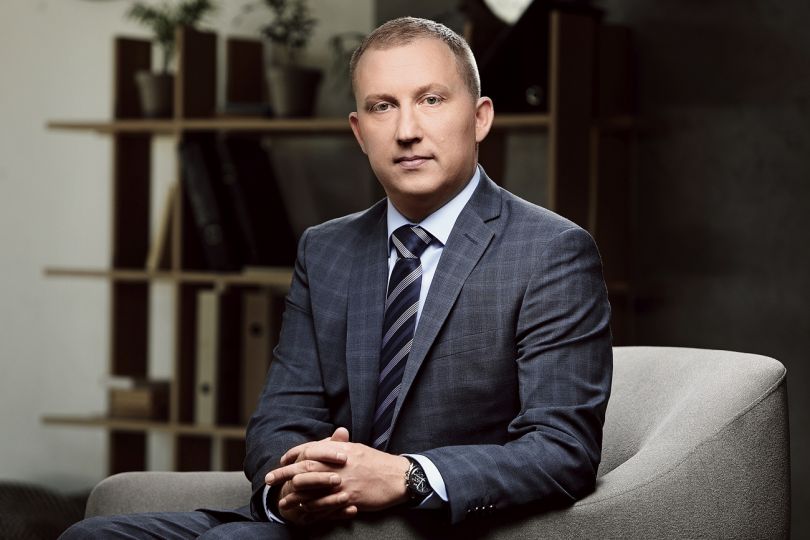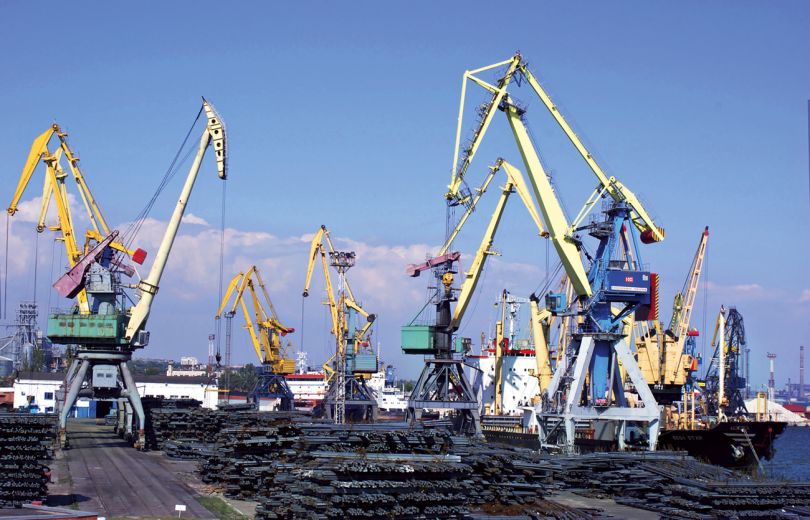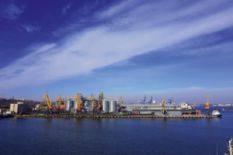The Ukrainian Sea Ports Authority (USPA) is one of the largest state enterprises, which has strategic importance for the economy and security of Ukraine. Raivis Veckagans, the Head of the USPA, shared its plans for development with the Destinations.
– How do you assess the current state of the Ukrainian port industry and its potential?
The port industry of Ukraine works without any failures and is actively developing now.
For the second year in a row, the volume of cargo transshipment through seaports is increasing. The interest of investors as well as the volume of investments in the infrastructure in general is growing. Moreover, not only the USPA as a state enterprise responsible for the development of ports in general, but private business as well – both Ukrainian and international – are investing in the development of port capacities. The volume of our investments in the last two years has increased 2.5 times comparing to 2015-2016. The total portfolio of public-private partnership projects of the USPA and business is estimated at about UAH 30 billion.
Over the next few years, these funds will be invested in the development of the port infrastructure. Such positive dynamics is built up against the background of a number of well-known problems that our country has had to face in the past five years. Because of the actions of the Russian Federation, we temporarily lost control over five ports in Crimea. Since 2014, the situation in Donbas has led to the reduction in the cargo base in this region and to the forced change in transport routes. Freight logistics has become longer and more expensive. The construction of the Kerch Bridge in 2017 and subsequent unjustified inspections of ships going to the Ukrainian ports in Azov resulted in a two-fold drop in transshipment and vessel calls at the ports of Mariupol and Berdiansk.
Despite all this, Ukrainian ports are surviving and developing – in such difficult conditions, the Mariupol State Stevedore is creating a joint grain terminal with private business, and other ports are building new capacities. Therefore, yes, our ports have a great potential for growth and development, and the current growth in cargo traffic, an increase in the number of investment projects is an evidence of this. The USPA, together with the Ministry of Infrastructure of Ukraine, has developed a port development strategy for 20 years ahead. According to conservative forecasts, transshipment volumes for this period will increase to 184 million tons, and according to optimistic ones – to 246 million tons. This will be facilitated by the implementation of 40 investment projects envisaged by the strategy, which will create 4,000 jobs in the industry.
– What are the priority tasks for the modernization and development of the port infrastructure of Ukraine?
Our priorities are modernization and construction of new berths and other hydraulic structures, as well as the development of water areas – maintenance of the passport depths of the ports’ water area, implementation of capital dredging projects to improve working conditions in ports and increase their competitiveness. Particularly for these purposes 70% of the USPA capital investment is directed.
Our ports have a great potential for growth and the increase in the number of investment projects is an evidence of this.

– The lion's share in the structure of the cargo turnover of seaports is export. What are the main points of growth in this direction?
There are several areas of growth. If we talk about ports, this is primarily dredging (what the USPA does) and modernization of cargo terminals owned by private and state stevedoring companies. The first one allows to maximize the potential of the water area and take vessels with the maximum port draft, and therefore dispatch large shipments of cargo, making logistics more profitable. The second one reduces the time necessary for processing a vessel in the port, which leads to lower freight costs and again makes transportation less costly.
The next important area is the integrated development of the country's transport infrastructure. Ports are now far from being 100% loaded. However, even with this volume it is not always possible to cope with rail transport and road hauliers, especially if you follow the norms of cargo transportation by road. Port railway stations were designed in Ukraine for operation mainly with imported cargo. Now the situation has changed to the opposite: export in Ukrainian ports amounts to almost three quarters of transshipments. Modernization of railway stations lags behind the re-targeting of freight traffic. The USPA is now actively working with Ukrzaliznytsia and stevedores on the implementation of development projects for port railway stations in Odesa and Mykolaiv. We are also in dialogue with local authorities in the port cities to optimize the movement of freight transport to the ports through the cities or taking a detour.
– Infrastructure projects are among the most costly. What, in your opinion, should the state policy be in order to attract as many investors as possible?
The effective public-private partnership is the key to attracting investments to the industry. Various forms of PPP are already working in Ukrainian ports. This year we want to make available to investors another well-established format of cooperation in the port industry of the world – a concession. Through concession agreements, such ports as Antwerp, Piraeus, Foz, Constanta, Singapore were able to attract the world's largest companies and shipping lines, to significantly increase their capacity and cargo turnover. Ukraine is now preparing to launch pilot projects for the concession of state stevedores in the ports of Olvia and Kherson.
Their conditions were developed by reputable international consultants with the active participation of the Ministry of Infrastructure, EBRD, IFC. The estimated volume of investments attracted to the development of these two ports in the framework of the concession is more than USD 65 million. In addition, it is planned that the volume of transshipment and deductions to local budgets will double.
– What forms of cooperation with the Ukrainian Sea Ports Authority are the most interesting for potential investors?
We try to be open and interesting for everyone. Both – for big business, with which dozens of memorandums have been signed for the joint implementation of large-scale projects for the construction and reconstruction of berths, terminals, infrastructure modernization, and dredging. And for small and medium businesses, for which, for example, we offer for rent unused berths in small ports and port stations, non-core assets, etc., which can be effectively used and be beneficial.
All over the world, investment attraction recipes are the same. Interesting and promising, well-thought-out projects, minimization of the human factor in the licensing and controlling areas (read as leveling the corruption component), stable and clear conditions for doing business.
– What contributes to building partner confidence and effective business communication?
In my opinion, the main argument should be openness, so that potential partners can discuss the current situation on an equal footing, make plans and move towards their implementation. Based on this ideology, for the second year in a row we arrange the Ukrainian Ports Forum in Odesa. This is the main business event of the industry, where all participants have the opportunity to establish effective communication, discuss key trends and outline ways to implement joint projects. This year the topics for discussion at the forum will be as follows: integration of the transport infrastructure of Ukraine and EU, ensuring safety of navigation in the Black and Azov Seas, development of transshipment of the main types of cargo in Ukrainian ports (agricultural, industrial and container). We also update information for potential participants of concession pilot projects in ports. And together with the business we will make the list of tasks for the development of the industry in the coming years.
– In times gone by, the famous trade routes passed through the territory of Ukraine – the Silk Road and the trade route from the Varangians to the Greeks. What can be the place of modern Ukraine in the global maritime commerce?
Maritime Silk Road through the Suez Canal and Bosphorus exists now, and I believe that its development is quite promising for Ukraine. Now we are building a strategy to attract cargo from Asia through this and other multimodal routes. Today, some groups of goods from China to Ukraine are delivered by sea through Gdansk, Poland. This is about 55 days around Europe via the Suez Canal and then by land. We can make our route through Ukraine faster and cheaper.

The USPA is also actively developing new transit routes towards Georgia, Turkey, Iran, and in the direction of import – to Moldova, Belarus. We can create competition to the Baltic ports and offer Belarus to export to China via the Black Sea. In addition, in 2018, the development maps of the European transport network TEN-T in the Eastern Partnership countries, including Ukraine, were made public. Eight of our ports are included in this network: Mykolaiv, Odesa, Chornomorsk, Yuzhnyi, Mariupol are assigned to the core network (core), and Izmail, Reni and Kherson – to the important (comprehensive) network. As part of the Eastern Partnership initiative, together with the Ministry of Infrastructure of Ukraine, we worked through and included in the TEN-T investment plan nine prospective infrastructure projects of the port industry until 2030 totaling Euro 844 million. This opens up new opportunities for Ukraine to actively use seaports and inland waterways to transport goods to the EU, as well as transit products from the EU countries through Ukrainian territory.
Let us not forget about the potential of cruise and passenger traffic between our countries. Already, we can see a good positive trend in terms of growth of cruises from Austria to Ust-Dunaisk. And a city like Ismail with the recently opened after reconstruction Marine Passenger Terminal can become the main water gate of Ukraine to the EU in the Danube region.
If we want to see Ukraine as a state-of-the-art and efficient country, state enterprises are obliged to be like this.
– Modern business space conditions require flexibility of management models and readiness for transformation. Is it possible to adhere to these principles in such a large-scale industry as the port industry?Do you manage it?
It's a great question! My answer is: it is possible and necessary. Indeed, the USPA is one of the largest and most strategic state-owned enterprises, and such companies are very sluggish. But if we want to see Ukraine as a state-of-the-art and efficient country, state enterprises are obliged to be like this. I am very pleased that the USPA has become one of the first enterprises in which the reform of corporate governance is being implemented. I am sure that we will be able to bring the USPA to the standards of transparency and efficiency. We focus on the principles defined by the Organization for Economic Cooperation and Development (OECD) for enterprises around the world.
– How do you see the Ukrainian port industry in 10 years?
We have developed the “Strategy for the development of the port industry till 2038”; now it is under review for agreement by the Cabinet of Ministers.
One of our main tasks is to complete the reform of the port industry and the transition to the landlord port management model that is widespread in the EU. It provides for a broad interaction between the port administration and the municipalities. Also within this model, the port administration has a right to dispose of a land bank, the entire port infrastructure, for example, to implement projects of public-private partnership (lease, concession). Over the next 20 years, we are planning to bring Ukrainian ports into the TOP 30 of the LPI index of the World Bank and the Global Competitiveness Index of WEF.







